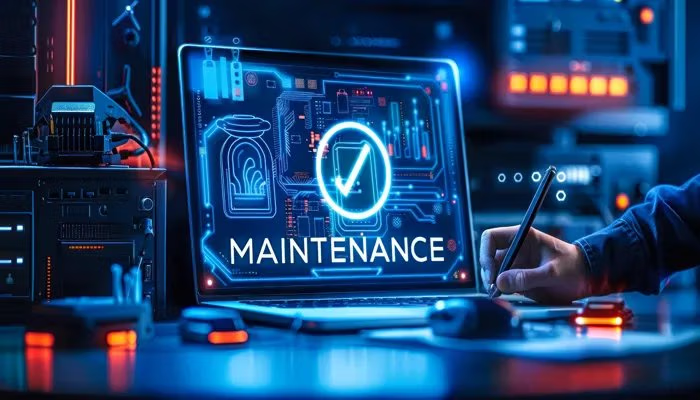Summary: CMMS software is a powerful tool that can revolutionize maintenance management by streamlining processes, optimizing resource allocation, and maximizing equipment uptime. By implementing CMMS software, organizations can enhance maintenance efficiency, reduce costs, and make data-driven decisions to improve overall performance. When choosing a CMMS solution, assess your maintenance needs, consider scalability and integration, evaluate user-friendliness, and check customer support and pricing. By addressing common implementation challenges and ensuring user adoption, organizations can unlock the full potential of CMMS software and reap its benefits.
Exploring CMMS
Computerized Maintenance Management System (CMMS) also referred to as maintenance software or CMMS software serves as a tool for maintenance teams. This software streamlines maintenance operations. Is recognized as one of the top-notch options available. Maintenance teams leverage the software for scheduling and monitoring tasks managing inventory efficiently and generating reports promptly. With its functionality in managing work orders, teams can rely on CMMS, for operational efficiency. Furthermore, providers of CMMS software offer a range of options, including versions and cloud-based solutions. Similar, to EAM solutions CMMS streamlines maintenance management making it a crucial system for any organization. By utilizing maintenance management software teams can enhance their workflow. Maximize the potential of the CMMS database.
The Development of CMMS
The origins of CMMS traced to the 1960s when maintenance professionals began using iterations of computerized systems to oversee maintenance activities. Over time CMMS has transformed into a tool with features and functionalities. Contemporary CMMS systems can also integrate with software platforms like Enterprise Asset Management (EAM) systems to deliver maintenance management.
How can maintenance teams work more effectively?
Our maintenance management software enhances planning, tracking, and execution.
The Evolution of CMMS; From Traditional Methods to Digital Solutions
Maintenance management relied heavily on techniques such as pen and paper or spreadsheet-based systems. However, as technology progressed businesses acknowledged the necessity for automated approaches. This paved the way, for the development of maintenance management systems revolutionizing how maintenance tasks are handled.
Key Attributes of CMMS Software
Management Work Orders and Scheduling
A feature of CMMS software is its capability to generate and oversee maintenance work orders.
With a, easy-to-use interface maintenance teams can efficiently create work orders assign tasks to technicians, and monitor the progress of each task. Moreover, CMMS software facilitates scheduling to ensure that maintenance tasks are planned and executed in a manner.
Planning for Preventive Maintenance
Preventive maintenance plays a role in minimizing equipment downtime and prolonging the life of assets. CMMS software offers planning features for maintenance allowing teams to schedule regular inspections, lubrications, and other preventive activities. This proactive approach helps address maintenance requirements and prevent breakdowns and unexpected downtimes.
Managing Inventory
Efficient inventory management is crucial for maintenance operations. CMMS software serves as a centralized platform for managing parts, tools, and equipment. It empowers maintenance teams to monitor inventory levels, automate reordering processes, and maintain stock levels. This ensures that technicians have access, to resources when needed reducing equipment downtime.
Tracking Equipment and Asset Maintenance
CMMS software enables organizations to maintain a database of their equipment and assets. Each piece of equipment can be recorded in the system with specifications, maintenance history, and warranty details. This functionality allows maintenance teams to track activities effectively identify recurring issues and make decisions regarding asset maintenance and replacement.
Reporting and Data Analysis. Maintenance management software offers reporting and analytics features that provide maintenance managers with insights, into maintenance operations and performance. Managers can monitor metrics using reports and dashboards such as maintenance expenses, equipment uptime, and work order completion rates. This information enables organizations to spot trends enhance maintenance strategies and make informed decisions to boost efficiency.
Advantages of Maintenance Management Software
1. Streamlining Maintenance Processes
By implementing maintenance management software maintenance teams can streamline their operations by utilizing a platform for managing tasks, schedules, and resources. With this software maintenance professionals can easily create work orders assign them to the technicians and track progress in time. This improves communication flow. Reduces the risk of misunderstandings or overlooked tasks. Additionally, the software automates processes like report generation and notification delivery, saving time and increasing overall effectiveness.
2. Enhancing Preventive Maintenance Practices
One benefit of maintenance management software is its capacity to optimize maintenance efforts. Maintenance teams can ensure inspections and tasks by setting up maintenance schedules within the software. The software sends reminders and notifications when it’s time for scheduled maintenance activities minimizing the chances of equipment failures and costly repairs. This proactive approach, to maintenance helps organizations prevent downtime and prolong the lifespan of their assets.
3. Reducing Maintenance Expenses
The use of CMMS software can significantly impact the reduction of maintenance costs. By implementing maintenance strategies and detecting issues early organizations can steer clear of expensive emergency repairs and equipment breakdowns. Additionally, CMMS software aids, in optimizing inventory management by monitoring parts and supplies ensuring that maintenance teams have the resources without excessive stockpiling. Furthermore, the data and analysis provided by CMMS software allow organizations to pinpoint areas of inefficiency and make cost-saving decisions based on data.
4. Improving Asset Management
asset management plays a role in various industries. CMMS software enhances asset management by offering visibility and control over assets. Through CMMS organizations can maintain a database with asset information such, as maintenance history, warranties, and specifications. This information aids in making choices regarding asset upkeep, repair, or replacement. By optimizing asset management organizations can maximize asset utilization reduce downtime and enhance efficiency.
Challenges Encountered in Implementing CMMS Software
Although CMMS software brings about various advantages organizations may confront hurdles during the implementation phase. Here are some common obstacles and suggestions to tackle them;
Resistance to Change
When introducing a software system employees who are used to existing procedures may resist the change. To address this issue it is crucial to involve stakeholders, from the outset communicate the benefits of the CMMS software effectively, and provide training and support for a seamless transition. Emphasize how the software can positively impact their work and highlight its long-term advantages.
Data Migration and Integration
Migrating existing maintenance data to CMMS software and integrating it with systems can pose challenges. Carefully plan the data migration process to ensure the accuracy and integrity of data. Collaborate with the CMMS vendor or IT professionals to streamline integration efforts and facilitate data exchange between systems.
User Adoption and Training
Effective training programs and user adoption play a role in CMMS implementation. Offer training sessions, for maintenance teams that focus on understanding the software’s features and functionalities. Provide support. Encourage feedback to address any issues or queries that may arise. User-friendly interfaces and intuitive workflows also contribute to rates of user adoption.
Choosing the CMMS Software
Assess Your Maintenance Requirements
Before choosing a CMMS software solution it is crucial to assess your organization’s maintenance needs. Factors to consider include the size of your maintenance team the complexity of tasks involved in maintenance operations and any industry-specific demands. Identifying the features and functions you need in a maintenance management system (CMMS) is crucial. These may include managing work orders, scheduling maintenance handling inventory, and generating reports. By understanding your maintenance requirements you can narrow down your choices. Select a CMMS software that best fits your needs.
Assessing Key CMMS Features
When examining CMMS software options it’s important to focus on vital features, for your organization. Look for aspects like user interface, ease of operation, and scalability. Make sure the software provides work order management functionalities for the creation of assignments and tracking of work orders. Evaluate the software’s maintenance scheduling capabilities along with its inventory management features. Additionally, consider the reporting and analytics tools offered as they can provide insights for decision-making and enhancing maintenance operations.
Taking into Account Scalability and Integration
As your organization expands so will your maintenance demands. Therefore selecting a CMMS software that can meet your needs is essential. Assess the software’s capacity to handle increasing assets, users, and maintenance tasks. Also, look at its integration capabilities. Choosing a CMMS that can seamlessly integrate with systems, like Enterprise Asset Management (EAM) or accounting software enables data exchange leading to improved operational efficiency.
FAQ | CMMS Software
What is the difference between CMMS and EAM?
CMMS (Computerized Maintenance Management System) software focuses on managing maintenance operations, such as work orders, preventive maintenance, and inventory management. As a subset of maintenance management software, CMMS is designed to streamline day-to-day maintenance tasks.
On the other hand, EAM (Enterprise Asset Management) software encompasses a broader scope, including maintenance management, asset lifecycle management, asset tracking, and financial management.
Can CMMS software help in reducing reactive maintenance?
Yes, CMMS software can help reduce reactive maintenance. Organizations can identify and address potential issues by implementing preventive maintenance strategies and scheduling regular inspections before they result in unplanned breakdowns. This proactive approach minimizes reactive maintenance and improves overall equipment reliability.
How can CMMS software streamline preventive maintenance scheduling?
CMMS software streamlines preventive maintenance scheduling by automating the process. It allows organizations to create maintenance plans, define task frequencies, and schedule preventative maintenance activities in advance. The software automatically generates work orders and sends notifications to technicians, ensuring that preventive maintenance tasks are executed on time.
Is CMMS software only suitable for large organizations?
No, CMMS software is suitable for organizations of all sizes. While large organizations may benefit from the scalability and advanced features of CMMS solutions, small and medium-sized businesses can also leverage CMMS software to streamline their maintenance operations, improve efficiency, and reduce costs.
Whether managing complex industrial facilities or maintaining a smaller fleet of equipment, a maintenance app provides a flexible and accessible solution for tracking work orders, scheduling preventive maintenance, and ensuring asset reliability.
Can I try out CMMS software before making a purchase?
Many CMMS software vendors offer trial versions or demonstrations of their software. This allows organizations to explore the features and functionalities of the software before making a purchase decision. Please take advantage of these trial periods to assess the software’s suitability for your organization and evaluate its ease of use and compatibility with your maintenance processes.
Image: Adobe Stock – Copyright: © Bartek – stock.adobe.com





